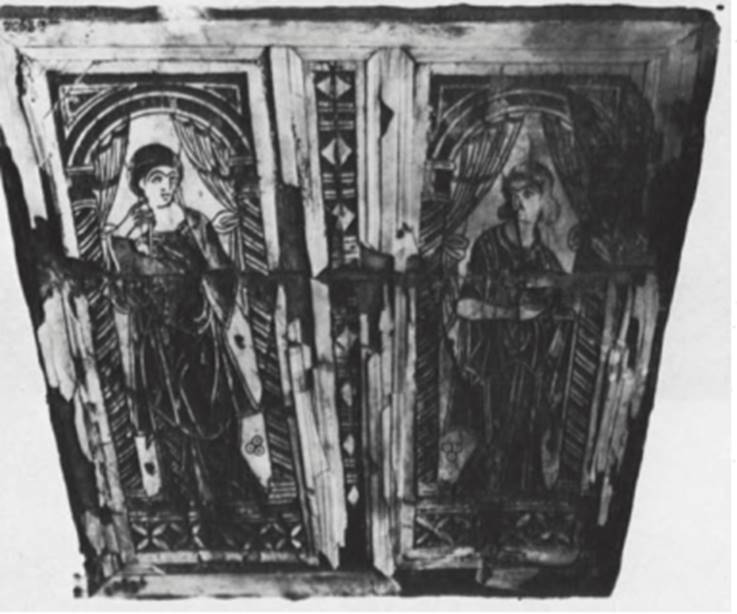Panels from a bridal casket. Egypt, 4th century Wood, bone, and wax
Two complete panels and one half panel are all that remain from this casket. Like the Projecta casket (no. 310), this is considered by many scholars to have been a bridal casket. The lid and body were each in the shape of a truncated pyramid and the principal decorative motif consisted of figures under arches draped with curtains. As far as is known, however, this casket bore no indication of the owner's name or of whether she was a pagan or a Christian. The three remaining plaques are cut in intaglio and filled with red and black wax. They are among the finest examples of incised bone plaques.

The rectangular top of the cover has two plaques framed by canted borders. Each shows the bride standing on the right looking at her attendant on the left, both under one arch. Although portrayed frontally, each figure turns slightly outward. They stand on a row of quatrefoils. The bride wears a full-length tunic and a white palla. Her hair is held in place by a band. Her attendant also wears a long tunic—but it has a decorative band around the neck and ornamented clavi—and over this, a mantle. The attendant's hair is gathered loosely at the nape of the neck. In the right-hand plaque the bride holds a roll or a white tablet and the attendant, a casket. In the left, the bride holds a mirror and the attendant a case. Although much of the image is missing, Buschhausen (1971) has suggested that the bride is probably taking clips for her hair from her attendant.
The representations on the two end panels are similar, except that only one figure stands under each arch and on the second panel the entire lower portion is missing. The complete panel shows the bride on the left gently brushing back her veil with her right hand. The attendant holds a red tablet. An ornamental strip with a bead-and- reel pattern separates the two fields. The other end plaque shows the bride on the right holding a roll and the attendant on the left supporting a large shell (?) on her left arm. A row of quatrefoils separates the two fields, and a small portion of molding still remains on the right side. Two pieces with moldings from the original cover are still intact.
As has been noted by Weitzmann ([1], 1972, III, no. 6), incised plaques like these were fashionable in Egypt for a limited period. They are usually dated in the third or fourth century. On caskets they were used in combination with plaques carved in relief, as in the one in the Walters Art Gallery in Baltimore. The Cairo casket probably also originally had some panels in relief. Found at Saqqara. Bibliography: Strzygowski, 1904, nos. 7060-7064; Busch- hausen, 1971, pp. 217-219.
Date added: 2025-08-31; views: 76;
